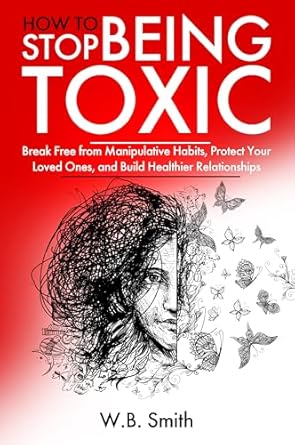Are you ready to transform your relationships and break free from toxic habits that hold you back? In “How To Stop Being Toxic: Break Free From Manipulative Habits, Protect Your Loved Ones, and Build Healthier Relationships,” you’ll discover practical tools designed to help you recognize and alter the behaviors that strain your connections with others. This accessible guide offers transformative techniques tailored for everyone—from teens to adults—empowering you to cultivate empathy, enhance your emotional intelligence, and set healthy boundaries without guilt.
Forget feeling overwhelmed by guilt or fear! This book is more than just theory; it’s packed with real-life examples, interactive exercises, and actionable insights that resonate across all walks of life. Whether you’re seeking to heal past traumas or improve your self-esteem, this guide is your key to personal growth and meaningful connections. Ready to embark on a journey toward healthier relationships? Scroll up and click “Add to Cart” to start your transformation today!
How To Stop Being Toxic: Break Free From Manipulative Habits, Protect Your Loved Ones, and Build Healthier Relationships
Why This Book Stands Out?
- Transformative Techniques: Discover actionable strategies to identify and change toxic behaviors that hinder genuine connections.
- Holistic Healing: Learn the vital first steps to address past trauma, setting the stage for future growth and healthier relationships.
- Enhanced Emotional Intelligence: Develop skills to respond thoughtfully, fostering deeper understanding and compassion in your interactions.
- Interactive Exercises: Engage with practical journaling and mindfulness activities that enhance self-awareness and emotional well-being.
- Empathy Cultivation: Explore methods to build empathy daily, transforming your relationships through deeper understanding.
- Effective Communication: Master strategies that ensure your feelings are communicated clearly and compassionately, reducing conflict.
- Narcissism Awareness: Gain insights into recognizing and addressing narcissistic traits within yourself and others with compassion.
- Self-Esteem Improvement: Shift from self-critique to self-compassion, creating a healthier self-image.
- Protection from Gaslighting: Understand gaslighting dynamics and learn how to safeguard yourself and loved ones.
- Self-Care Practices: Discover how to nurture authentic connections while prioritizing your own self-discovery.
- Manage Emotional Baggage: Learn to lighten your emotional load, paving the way for more fulfilling relationships.
- Embrace Vulnerability: Overcome the fear of vulnerability to strengthen your relationships with confidence.
- Stress Coping Mechanisms: Develop tools for managing stress that lead to emotional stability and resilience.
- Continuous Growth: Recognize signs of your improvement, encouraging ongoing personal development.
- Real-Life Examples: Benefit from relatable scenarios and practical guidance that resonate with readers from all backgrounds.
Personal Experience
As I delved into How To Stop Being Toxic, I found myself reflecting on my own journey and the relationships that have shaped me. It was as if the pages were speaking directly to my experiences, echoing moments where I felt trapped in negative cycles. I could relate to the struggle of wanting to connect deeply with loved ones yet feeling like something always held me back. This book was not just a read; it was a gentle nudge towards self-discovery and healing.
One of the aspects that struck me was the emphasis on recognizing toxic behaviors. I remember instances where I would unintentionally hurt friends or family, often out of fear or past trauma. The book provided a clear framework for understanding these actions, which felt liberating. It made me realize that acknowledging my flaws was the first step towards genuine connection.
Here are a few key insights that resonated with me:
- Transformative Techniques: The methods for identifying and altering harmful patterns felt like a roadmap to a healthier me. I appreciated the practical exercises that encouraged me to reflect on my behavior.
- Healing Past Trauma: The book discusses the importance of healing and how it can pave the way for stronger relationships. This hit home for me, as I realized that my past experiences were influencing my current connections.
- Enhancing Emotional Intelligence: Learning to respond thoughtfully instead of reacting impulsively was a game-changer. I began to practice this in my daily interactions, which led to less conflict and more understanding.
- Setting Healthy Boundaries: The guidance on establishing boundaries without guilt was particularly empowering. I had always struggled with this, but the book offered actionable steps that felt manageable.
- Empathy as a Game-Changer: Cultivating empathy was highlighted throughout the book, and I found myself reflecting on how I could be more understanding towards others, fostering deeper connections.
Reading through the chapters, I felt a sense of camaraderie with the author, as if we were walking this path together. The real-life examples and relatable scenarios made me feel less alone in my struggles. It was refreshing to see that personal growth is a journey, one that requires patience and self-compassion.
In moments where I felt overwhelmed by the idea of change, this book broke complex concepts down into bite-sized, actionable steps. It was reassuring to know that I didn’t have to tackle everything at once. I could take my time, gradually implementing the strategies and witnessing my progress. This approach made the journey feel less daunting and more achievable.
Each page served as a reminder that I am not defined by my past mistakes but rather by my willingness to grow and change. If you find yourself resonating with these feelings, I encourage you to explore this transformative guide. It may just spark the change you’ve been longing for.
Who Should Read This Book?
This book is perfect for anyone who feels like their relationships are suffering due to unhealthy patterns or toxic behaviors. Whether you’re a teen navigating the ups and downs of friendships, a young adult trying to establish meaningful connections, or an adult looking to mend and strengthen long-standing relationships, this guide is tailored for you. Here’s why you should consider diving into its pages:
- Teens: If you’re grappling with friendship dynamics, peer pressure, or self-identity, this book can help you recognize and shift toxic habits early, setting a strong foundation for your future relationships.
- Young Adults: As you step into adulthood, you may find yourself facing new relationship challenges. This book provides practical tools to navigate romantic relationships, friendships, and work dynamics with emotional intelligence.
- Adults: If you’re feeling overwhelmed by past traumas or toxic patterns in your long-term relationships, this guide offers actionable steps to heal and foster healthier connections with loved ones.
- Individuals Seeking Personal Growth: If you’re on a journey of self-discovery and want to break free from self-defeating behaviors, the insightful exercises and strategies can help you cultivate a stronger sense of self and emotional resilience.
- Those Tired of Feeling Stuck: If you’ve been searching for a way to break the cycle of toxicity in your life and relationships, this book is filled with real-life examples and practical advice that can spark meaningful change.
No matter your age or stage in life, this book is designed to meet you where you are, offering a friendly hand as you embark on your journey toward healthier relationships and personal empowerment. You deserve the tools to connect authentically and live free from the burden of toxic habits!
How To Stop Being Toxic: Break Free From Manipulative Habits, Protect Your Loved Ones, and Build Healthier Relationships
Key Takeaways
This book offers transformative insights and practical strategies to help you break free from toxic habits and foster healthier relationships. Here are the key points that make it a must-read:
- Learn to identify and change toxic behaviors that hinder genuine connections.
- Understand the first steps to healing past traumas and their importance for personal growth.
- Enhance your emotional intelligence (EQ) to respond thoughtfully instead of reacting impulsively.
- Engage in essential exercises to boost self-awareness through journaling and mindfulness.
- Establish and maintain healthy boundaries without feelings of guilt or overwhelm.
- Discover the power of empathy and how to cultivate it in your daily interactions.
- Master effective communication techniques that ensure your feelings are heard without conflict.
- Address the impact of narcissism in relationships with compassion and understanding.
- Improve your self-esteem by transforming self-critique into self-compassion.
- Gain insights on recognizing and protecting yourself and loved ones from gaslighting.
- Practice self-care through authentic connections and deep self-discovery.
- Learn how to manage emotional baggage, paving the way for healthier relationships.
- Embrace vulnerability and understand its significance in strengthening relationships.
- Develop coping mechanisms for stress that promote emotional stability and resilience.
- Acknowledge your progress and celebrate continual personal growth.
Final Thoughts
If you find yourself struggling with toxic patterns in your relationships, “How To Stop Being Toxic” is a must-read that offers real solutions for lasting change. This transformative guide empowers readers to break free from manipulative habits, heal past traumas, and cultivate healthier connections with loved ones. With practical exercises, relatable examples, and step-by-step strategies, this book is designed to resonate with teens, young adults, and adults alike, making it an invaluable resource for anyone seeking to improve their emotional well-being and interpersonal dynamics.
Here’s what makes this book a worthwhile addition to your collection:
- Comprehensive techniques to identify and change toxic behaviors.
- Steps to enhance emotional intelligence and communication skills.
- Insights on setting healthy boundaries and practicing self-care.
- Strategies to manage emotional baggage and foster resilience.
- A compassionate approach to addressing narcissism and gaslighting.
Don’t let the weight of past mistakes hold you back any longer. Take a proactive step toward personal empowerment and healthier relationships. Ready to embark on your journey of transformation? Click here to purchase your copy of “How To Stop Being Toxic” and start making a positive change today!





